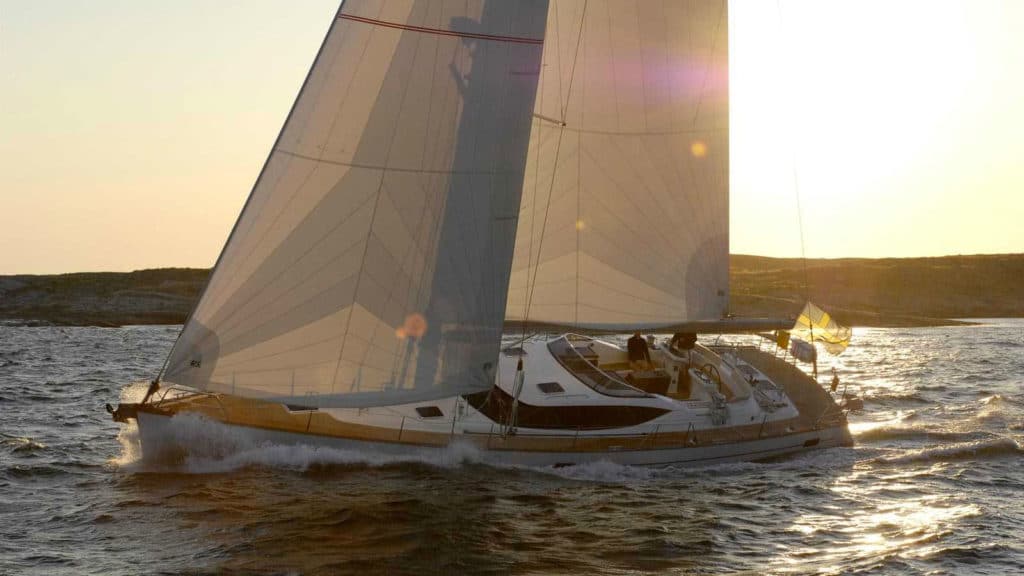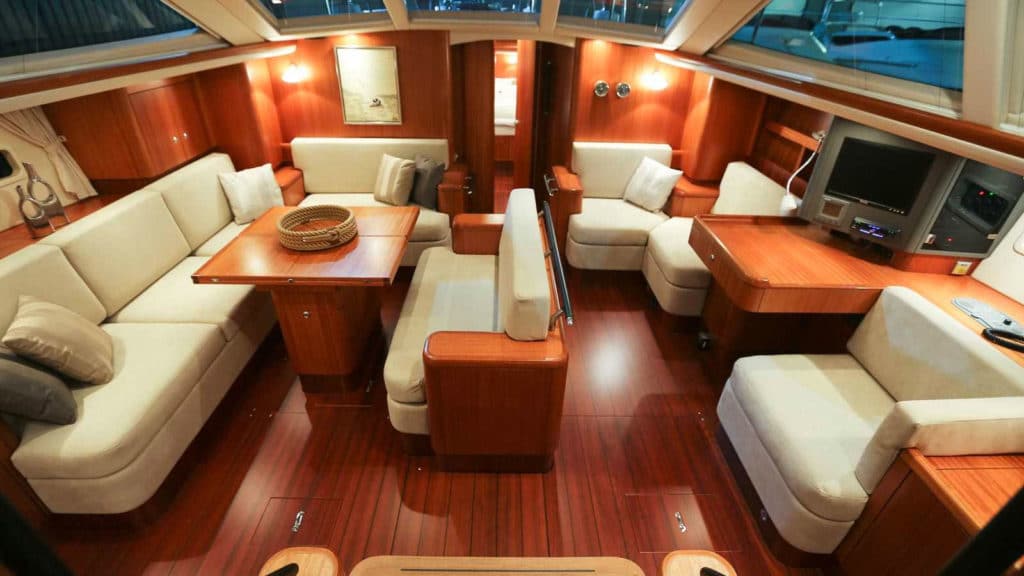
At most times, the entrance to Rhode Island’s Narragansett Bay would never bring to mind the southwest coast of Sweden or the Baltic Sea. But the morning I boarded the brawny Najad 570 in nearby Newport wasn’t your usual late-summer September day, nor was it a stretch to imagine that we were making our way through the very sorts of waters for which the boat was originally conceived.
An extremely staunch west-southwest breeze, matched with a tide at full ebb, was stacking up an impressive row of short, steep waves at the gateway to Rhode Island Sound. Soon enough, with about three-quarters of the Seldén furling main unfurled, and perhaps 100 percent of the Furlex furling jib unrolled and sheeted home, we found ourselves right in the middle of the rather boisterous seaway. The big, rock-solid 57-footer, shouldering aside the formidable chop on a tight, closehauled course (the apparent-wind angle was locked in at about 45 degrees—very good in wavy rollers), couldn’t have been happier. Me neither.
In marginal weather, it doesn’t take long to figure out if a boat would be better off on a mooring or if it’s ready to go anywhere and take whatever gets dished out. The 570 resides in the second category. Frankly, I’m not a huge fan of furling mainsails (an option to the standard, fully battened main), but this one, flat and forceful with an efficient set of vertical battens, could make me a believer.
Accompanied by the shortened headsail on the tall, three-spreader fractional rig, the evenly balanced boat was a delight to drive, with a ridiculously light helm at the twin carbon wheels. Muscling through the chop with ease and purpose, the SOG figures on the pedestal-mounted Furuno Navnet 3-D GPS/chart plotter wavered between 7.6 and 8.3 knots. I scribbled a quick thought in my notebook: “Plenty of grunt upwind. We’re sailing the 6-foot-8-inch shoal-draft version. Can’t image the 8-foot-9-inch full-draft version could be much better.” If it is: Oh, heavens.
Earlier, on the launch ride out to the boat, I’d made another notation: “Doesn’t look Swedish.” I realize this could be construed as a left-handed compliment, but I meant it in a positive way. The 570 isn’t a handsome boat in the traditional sense, but it has a very modern aesthetic. The nearly plumb bow and slightly angled reverse transom maximize the water length. There’s a surprising amount of freeboard and a long, flush teak deck forward of the mast; the teak is standard. This might’ve appeared clunky in the hands of naval architects less skilled than the collaborative German design team of Judel/Vrolijk & Co., but the low, generous center cockpit, coupled with the wraparound windows for the raised-deck saloon and the short afterdeck, pulls it all together visually. The little windscreen is a nice touch, a nod to the boat’s Scandinavian roots. On second thought: Let me just say it, this is a pretty good-looking yacht.
It’s also one rich in systems—this isn’t a boat for beginners. Our test yacht was powered by the optional 180-horsepower Volvo Penta diesel engine spinning a four-bladed prop; like all modern, fully electronic diesels, this one is meant to be operated at low revs, and it registered a solid 7 knots at 2,000 rpm. A Najad representative said the boat will make 11 knots opened up, but we were too anxious to go sailing to confirm it. We did spin the boat in its own length with the aid of the Max Power bow and stern thrusters, the joysticks for which are stationed at the twin pedestals (as are the repeaters for the Furuno autopilot, all the engine readouts and controls, a VHF radio, and so on). One thing about the Najad: It’s tough to see over the dodger from the steering stations. Consider a nit picked.
Everything else you might imagine topside is, well, topside: a complete Holmatro hydraulics package, a full suite of Andersen winches (of course, you can order the optional electric versions, which were installed on this version), a belowdecks Lofrans windlass coupled with a big Delta anchor and husky twin bow rollers, and a generous selection of Lewmar hardware and Spinlock clutches.
The vacuum-infused hull and deck are laid up in a sandwich consisting of vinylester resin and multi-axial E-glass over a Divinycell foam core. There are a couple of layers of epoxy primer below the waterline. The keel blade is cast-iron; the attached bulb is lead. The balanced spade rudder is hung off a solid stainless-steel rudder post. Did I mention this boat is a gas to steer?

One gains the interior accommodations via a four-step companionway. The layout and furniture, from interior designers Rhoades Young, is finished in light African mahogany with trim and flooring in another light wood, Brazilian jatoba. Combined with the natural light streaming in from the raised saloon windows, it creates an attractive, very inviting space and atmosphere.
In some ways, the large, walk-in engine room—which can be further accessed by removing the companionway stairs and a series of panels behind the straight-line galley, to port—is the centerpiece of the interior plan. That’s because the Najad 570 is a semicustom yacht, and owners have lots of leeway in how they arrange the staterooms. The forward-facing navigation station, to starboard, is the other fixed area; the table itself has seats on both sides for use as a social, lounging area at anchor or dockside. One very nifty feature is the fold-down switchboard, which provides ready access to fuses and circuit breakers, and an adjacent, removable panel to access fluxgate compasses, the Furuno black boxes, and related instrumentation.
Otherwise, you may lay out the 570 to suit your crew and itinerary. In the main saloon, you can install a “mid-sofa” opposite the L-shaped settee and dining table. The master stateroom aft can be replaced by a pair of twin double-berth cabins. You can choose a spacious private forward cabin with its own sofa and table, or instead request a second dedicated cabin with “bunk-style” berths. Or, if you have a captain on board—and some owners will—you can request the crew cabin to starboard, aft of the nav area, with its own enclosed head. It’s difficult to imagine that you’d be disappointed with any of the choices.
After our bouncy ride at the mouth of the bay, we turned, set the code zero on its own furler, and romped northward in relatively flat water at a wind angle of around 120 degrees apparent, sliding along at 8 to 10 knots as if on rails. It was an almost perfect sail, right up to the end, when we had to go home. Lucky is the sailor of a new Najad 570, who’ll already be there.
Specs
LOA 57′ 6″ (17.5 m.)
LWL 54′ 4″ (16.5 m.)
Beam 16′ 7″ (5.0 m.)
Draft (shoal) 6′ 8″ (2.1 m.)
(deep) 8′ 9″ (2.7 m.)
Sail Area 1,600 sq. ft. (164 sq. m.)
Ballast 16,400 lb. (7,438 kg.)
Displacement 57,200 lb. (25,945 kg.)
Ballast/D 30
D/L 145
SA/D 18.4
Water 220 gal. (800 l.)
Fuel 181 gal. (1,200 l.)
Holding 37 gal. (140 l.)
Engine Volvo Penta D4-180
Designer Judel/Vrolijk & Co.
Price $1,700,000
BerthonUSA/Scandinavian Yachts
(401) 846-8404
www.scandyacht.com
Herb McCormick, a Cruising World editor at large, is a veteran offshore sailor.








